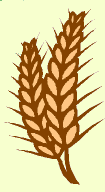
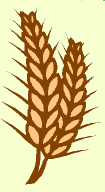
SHAVUOT
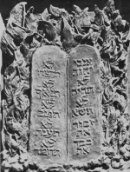
|
|
Knesset Menorah, Jerusalem. |
THE PURPOSE
Today most Jews celebrate Shavuot as the season of the giving of Torah (Revalation)
on Mount Sinai; nut originally it was known as  Yom Ha-Bikurim (The Day of First Fruits) 4. and also as Chag Ha-Katsir (The Festival of Ingathering) 5.
Shavuot was the beginning of the wheat harvest, just as Pesach was the beginning of the barley harvest.
Yom Ha-Bikurim (The Day of First Fruits) 4. and also as Chag Ha-Katsir (The Festival of Ingathering) 5.
Shavuot was the beginning of the wheat harvest, just as Pesach was the beginning of the barley harvest.
(4.) Numbers 28, 26. (5.) Exodus 23, 16.
THE DATE.
The Bible does not give a date to Shavuot; but what it does say is: And you shall count from the next day after the sabbath, from the day that you brought the sheaf of the wave offering; seven sabbaths shall be complete; To the next day after the seventh sabbath shall you count fifty days; and you shall offer a new meal offering to the Lord.6. From the context it is clear that the counting starts in or near Passover. There were various interpretations as to when we should start counting the seven weeks. The Saducees who did not accept oral interpretations of the Torah, took the word Sabbath literally and started counting on the day after the Saturday in Pesach. They always observed Shavuot on a Sunday. The Pharisees interpreted the word to mean a rest day and took it to refer to the first day of Passover, and so began counting on the second day of Pesach. By this method Shavuot always fell on the sixth of Sivan. After 70 CE when the second Temple was destroyed, the Pharisaism became main-stream Judaism, and so this is our current practice. The festival is sometimes called Pentecost (from the Greek for fifty) because it was the fiftieth day.
(6.) Leviticus 23, 15-16.
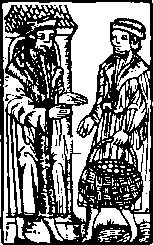
|
|
first fruits to the priest. Prague Haggadah.1526. |
HISTORICAL DEVELOPMENT.
The Festival of First Fruits as commanded in the Torah 7. was observed until the destruction of the second Temple in 70 CE. There is a brief description of the ritual in Deuteronomy 26 vs. 1 - 11. There is a longer and more detailed description in the Mishnah .8. The first fruits usually offered up were: wheat, barley, grapes, figs, pomegranates, olives, and date honey, for these were the species singled out in Torah as being typical produce of a fruitful land.9. Those living nearby brought fresh fruit while those coming from afar brought dried fruit.
After 70 CE when all sacrifices stopped, it eventually became necessary to give the festival a new significance. About the third century CE Shavuot became associated with the giving of Torah on Mount Sinai, which the Bible said took place about this time of year. R. Eleazar said: All agree in respect to the Feast of Weeks [�azereth] that we require [it to be a time of rejoicing] �for you�. What is the reason? It is the day on which the Torah was given.10. Neither Josephus, who lived at the time of the destruction of the Temple, or the Mishnah, dating from about 210 CE, speak of the historical significance of the festival. But the Talmud (c. 5th Cent.) mentions it several times.11.
In the 20th century, many of the Kibbutzim in Israel reintroduced the celebration of first fruits at Shavuot which often took place in the fields.
(7.) Exodus 34, 22, Leviticus 23, 25ff, Deut. 16, 9-10 and 26, 2ff. (8.) Bikkurim 3, 1 - 9. (9.) Deut. 8, 8. (10.) Pesachim 68b. (11.) Yoma 4b, Ta'anit 28b. and Shabbat 86b.

|
|
two tablets and hands on five books. Birds' Head Haggadah. Germany, c.1300 |
THE SIXTH OF SIVAN.
In order to give Shavuot historical significance, the Rabbis had to show that the Torah was given on the sixth of Sivan. They did this by interpreting verses in chapter 19 of Exodus.
In the third month after the children of Israel went out of Egypt, on the same day did they come to the Wilderness of Sinai.12. The third month is clearly Sivan. But no date is given. They concluded that in the same day meant the first of the month because the word hazeh was used in that sense elsewhere.13. This Talmudic logic is rather weak; but they also say that  Chodesh (month) can also mean new moon. So they read on the third new moon after the children of Israel came out of Egypt.14. On the second day Moses went up to God.15. On the third day Moses came[down] and summoned the elders of the people and put before them all that God had commanded him.16. On the fourth day Moses went back up and reported the words of the people to the Lord.17. God told him sanctify them today [still the fourth day] and tomorrow [fifth day] let them wash their garments.18. For on the third day [Sixth of Sivan] the Lord will come down in the sight of all the people on mount Sinai.19.
Chodesh (month) can also mean new moon. So they read on the third new moon after the children of Israel came out of Egypt.14. On the second day Moses went up to God.15. On the third day Moses came[down] and summoned the elders of the people and put before them all that God had commanded him.16. On the fourth day Moses went back up and reported the words of the people to the Lord.17. God told him sanctify them today [still the fourth day] and tomorrow [fifth day] let them wash their garments.18. For on the third day [Sixth of Sivan] the Lord will come down in the sight of all the people on mount Sinai.19.
(12.) Exodus 19, 1. (13.) Shabbat 86b. quoting from Exodus 12, 2. (14.) Mechilta ad. Loc. However it was only the second new moon after the exodus. (15.) Ex. 19, 3. (16.) Ex. 19, 7. (17.) Ex 19, 8. (18.) Ex. 19, 10. (19.) Ex. 19, 11.
ITS IMPORTANCE.
Shavuot is the second of the  three Pilgrim festivals,20. when all male Jews were expected to come to Jerusalem. Shavuot is a Yom Tov, full festival day, when no work should be done. In Synagogue the Hallel (psalms 113 - 118) is said. However, as a one-day festival it was sometimes considered less important than the seven-day festivals of Pesach and Sukkot. Today, it is still the least observed of the three, and yet its theme is the most important. The revelation on Mount Sinai was more important than the Exodus as it has formed the basis of the whole of Judaism.
three Pilgrim festivals,20. when all male Jews were expected to come to Jerusalem. Shavuot is a Yom Tov, full festival day, when no work should be done. In Synagogue the Hallel (psalms 113 - 118) is said. However, as a one-day festival it was sometimes considered less important than the seven-day festivals of Pesach and Sukkot. Today, it is still the least observed of the three, and yet its theme is the most important. The revelation on Mount Sinai was more important than the Exodus as it has formed the basis of the whole of Judaism.
Shavuot also suffers because it has less symbols than the other two. Passover has the Seder with all the various ritual foods, and Sukkot has the Lulav and Etrog and the Sukkah. Each of these is both colourful and memorable. Shavuot has little to compare to them. All it can offer are the reading of the Ten Commandments, the use of greenery in the Synagogue and the eating of milk-type foods. The last two of these are optional extras rather than required mitsvot. Because of the great importance of the event it celebrates, efforts have been made to make it more attractive.
(20.) Deut. 16, 16.
THE OMER.

When speaking about Passover the Torah says: And he shall wave the sheaf before the Lord, to be accepted for you; on the next day after the sabbath 21. The word sheaf was  Omer in the original Hebrew. An omer was a measure of volume or dry measure. (10 Omers = 1 Ephah 22.) Each day they used to bring an omer of barley from the new harvest and count off the 49 days. This counting process is still carried out but without the barley. In the evening service during the seven weeks we say This is the nth day, making x weeks and y days of the Omer. The period is known as the Counting of the Omer.
Omer in the original Hebrew. An omer was a measure of volume or dry measure. (10 Omers = 1 Ephah 22.) Each day they used to bring an omer of barley from the new harvest and count off the 49 days. This counting process is still carried out but without the barley. In the evening service during the seven weeks we say This is the nth day, making x weeks and y days of the Omer. The period is known as the Counting of the Omer.
(21.) Leviticus 23, 11. (22.) Exodus 16, 36.
THE LINK BETWEEN PESACH AND SHAVUOT.
Shavuot is linked to Pesach by the Counting of THE OMER.. From the time of the Mishnah Shavuot was often referred to as  Atseret.23. This meant the closing day of a festival as Shemini Atseret. It was therefore sometimes thought of as the last day of Passover.
Atseret.23. This meant the closing day of a festival as Shemini Atseret. It was therefore sometimes thought of as the last day of Passover.
The two festivals are also linked by their historical backgrounds. Passover commemorates the Exodus from Egypt and Shavuot as  Z'man Matan Toratenu, the Season of the giving of Torah. In an organised society people can not have complete freedom to do what they like, as this would lead to anarchy. The freedom of an individual has to subordinate to the need for members to live at peace with each other. For example someone can not have the freedom to steal from his neighbour. For this would only lead to strife and discord. So it is that the festival of Freedom is followed each year by the festival that celebrates the giving of Laws, and the intervening 49 days are counted publicly as if to stress the connection between them.
Z'man Matan Toratenu, the Season of the giving of Torah. In an organised society people can not have complete freedom to do what they like, as this would lead to anarchy. The freedom of an individual has to subordinate to the need for members to live at peace with each other. For example someone can not have the freedom to steal from his neighbour. For this would only lead to strife and discord. So it is that the festival of Freedom is followed each year by the festival that celebrates the giving of Laws, and the intervening 49 days are counted publicly as if to stress the connection between them.
(23.) Rosh Hashanah 1, 2. etc.
TORAH READINGS.
The two readings from the Torah on Shavuot are from Deuteronomy ch. 16 and from Exodus chs. 19-20. The Deuteronomy passage was read on Shavuot before 200 CE. The Mishnah lists it as the reading for the day.24. This reading speaks of the counting of the seven weeks and of the original harvest nature of the festival. The Exodus passage contains the giving of the Ten Commandments and is not mentioned in the Mishnah. This bears out the account of the HISTORICAL DEVELOPMENT of Shavuot in the Talmudic period as described above.
(24.) Meg. 3, 5.
THE BOOK OF RUTH.
The book of Ruth, one of the five Megillot, a group of books included in the K'tuvim (Writings) is read on Shavuot. This is a beautiful story of a young Moabite woman who chose to become associated with the Jewish people. Several reasons have been suggested for the choice of the book:
- The story takes place in the period of the barley harvest.25.
- Ruth said Your people shall be my people and your God my God26. This was taken as her conversion to Judaism and the taking on of all the duties required of a Jewess. Her acceptance of these was seen as similar to the Israelites acceptance of Torah at Mount Sinai.
- There is a tradition that King David, the founder of the line of the kings of Judah and the great grandson of Ruth, died on Shavuot.27.
- By reading Ruth we read from all three sections of the Tanach (the Hebrew Bible) and so this is a fit practice for Shavuot.
(25.) Ruth, 1, 23. (26.) Ruth, 1, 16. (27.) Ruth Rabbah 3, 2.
MILK FOODS.
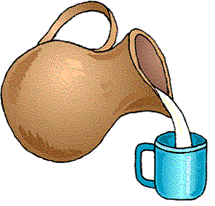
The eating of milk foods has come to be associated with Shavuot. This is not an actual requirement only a popular custom. Various reasons have been given for this:
- When the Torah was given at Sinai the people stood there all day. When they went back to their tents in the evening, they were so hungry that they could not wait for meat foods to be prepared, so they had fast-food ie. Milk dishes.
- Honey and milk are under your tongue28. Song of Songs was traditionally interpreted allegorically and so this phrase was taken to refer to the Torah.
- It is similar to a Seder when it is traditional to have two courses the first being an egg in salt water. This is assumed to be parallel to the two sacrifices on the festival. But at Shavuot the first dish is a milk or cheese food.29.
- In the Torah, the rule about first fruits is immediately followed by a law about milk.30.
- As meat was almost a luxury food, eating milk dishes showed restraint. Observance of Torah requires us to use restraint.
- A cynic has suggested that the reason is that most Jews are very fond of cheesecake.
(28.) Song of Songs 4, 11. (29.) S.A. Orach Chayim 494,3. (30.) Exodus 23, 19.
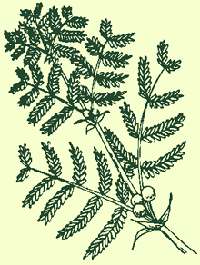
GREENERY IN SYNAGOGUE.
Many Synagogues are decorated with flowers and green leaves for the festival. Sometimes the green leaves were put on the floor. Explanations suggested for the greenery are:
- It is a reminder of the greenery at Mount Sinai. The Bible records the existence of at least one bush that grew there. 31.
- It is a reminder of the agricultural origin of the festival.
- God was thought to judge fruit trees on Shavuot and decide their future.32.
- Prayers are said at Shavuot for fruit trees.33.
(31.) Exodus 3, 2. Horeb and Sinai were names for the same place. See v. 12. (32.) Rosh Hashanah 1, 2. (33.) Rosh Hashanah 16a.
LATE NIGHT STUDY.
Some Jews spend the night of Shavuot in study. This is a late custom in two senses of the word. For it was not introduced until the 16 th century CE When some mystics in Safed under the leadership of Isaac Luria started the custom basing it upon a passage in the Zohar. 34. (The Zohar was a mystical work attributed to Simeon ben Yohai 2nd cent. CE but were actually written by Moses de Leon in the 13th century.) There is a legend that on the morning that the Torah was given, the Israelites overslept and were woken by the thunder over Mount Sinai. Therefore in some communities the custom was introduced of staying awake and studying through the night. The passages usually studied were taken from each book of the weekly Sidras and each Tractate of the Mishnah, to which were added some passages from the Zohar.
(34.) Emor, 98a.
| FOR ALPHABETICAL INDEX OF CUSTOMS |
 Shavuot means Weeks so the festival is sometimes called the Feast of Weeks. 1. The Torah states that the festival occurs seven weeks after Passover, the beginning of the barley harvest: Seven weeks shall you count; begin to number the seven weeks from such time as you begin to put the sickle to the grain. And you shall keep the Feast of Weeks to the Lord your God with a tribute of a freewill offering of your hand, which you shall give according as the Lord your God has blessed you.2. These seven weeks was sometimes regarded as a week of weeks.3. The plural in Hebrew is sometimes used in this sense.
Shavuot means Weeks so the festival is sometimes called the Feast of Weeks. 1. The Torah states that the festival occurs seven weeks after Passover, the beginning of the barley harvest: Seven weeks shall you count; begin to number the seven weeks from such time as you begin to put the sickle to the grain. And you shall keep the Feast of Weeks to the Lord your God with a tribute of a freewill offering of your hand, which you shall give according as the Lord your God has blessed you.2. These seven weeks was sometimes regarded as a week of weeks.3. The plural in Hebrew is sometimes used in this sense.